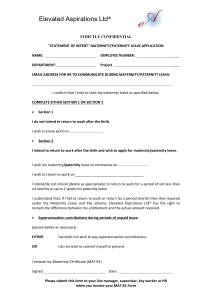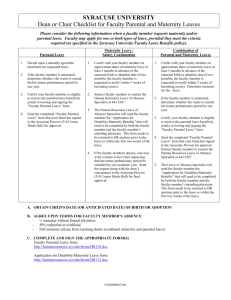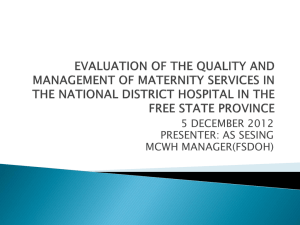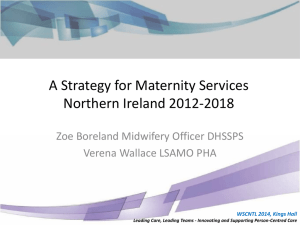Guidance on returning to work - Equality and Human Rights
advertisement
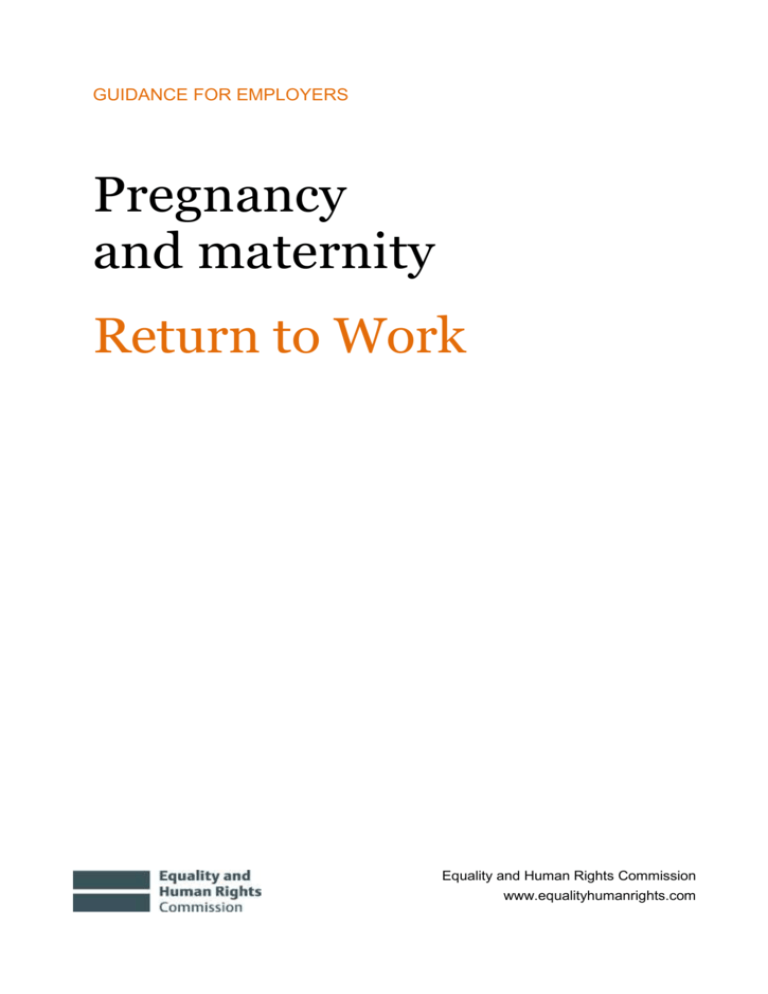
GUIDANCE FOR EMPLOYERS Pregnancy and maternity Return to Work Equality and Human Rights Commission www.equalityhumanrights.com Pregnancy and Maternity Guidance for Employers: Return to Work Introduction This guidance covers your legal obligations to new parents and parents-to-be. It covers birth parents and partners of an employee recognized as a main adopter. It highlights examples of good practice that go beyond the minimum that the law requires. Following these steps encourages clear communication between employers and employees and can help you recruit and retain good people but each business must decide its own approach. Rights on return to work after leave If an employee returns to work during (or at the end of) any of the following; • Ordinary Maternity Leave • Ordinary Adoption Leave (the first 26 weeks of leave) paternity leave • Additional Paternity Leave or • Shared Parental Leave where they have taken total leave of 26 weeks or less on aggregate (including any other periods of statutory leave) they are legally entitled to return to the same job they were doing before the start of the leave, on the same terms and conditions they had before. They must be given any pay rises (or improvements in other terms and conditions) that would have applied if they had not been away. If an employee returns to work during or at the end of; • Additional Maternity Leave • Additional Adoption Leave (the second 26 weeks of leave) • Shared Parental Leave where they have taken total leave of more than 26 weeks on aggregate (including any other periods of statutory leave) they are usually entitled to return to the same job on the same terms and conditions as if they had not been absent. However, if it is not reasonably practicable for the employee to return to his or her original job, they have a legal right to be offered a suitable alternative job. The new job must be both suitable and appropriate for the employee and on terms and conditions of employment which are ‘no less favourable’ than the employee’s previous job. Equality and Human Rights Commission · www.equalityhumanrights.com Published July 2015 2 Pregnancy and Maternity Guidance for Employers: Return to Work A less favourable role could be one where the work is less senior, less interesting or there is less responsibility. Or where changes have been made which make the role less attractive or where earnings from commission or performance-related pay may be reduced, or where the new post is more likely to be facing redundancy. If a woman is given a different job on her return to work and this is partly or wholly due to her absence on maternity leave, she may have a claim for maternity discrimination and/or for constructive unfair dismissal if the new job is less favourable than her previous job. Example — Martha returns to work after nine months’ maternity leave, having given notice to return to work early. Her maternity cover is kept on in Martha’s previous role and Martha is given the same type of work but in a different department. Despite the fact that Martha was returning to work during Additional Maternity Leave she should have been allowed to return to the job she was employed in before the start of her leave. If the employer wishes to continue to employ her maternity cover, the employer could offer that employee any other suitable vacancies. An employee’s rights on returning to work may differ if the employee takes further periods of Parental Leave after taking maternity, paternity or adoption leave. Can I ask my employee when she intends to return to work? Yes, it’s good practice to hold a pre-maternity leave meeting with your employee, at which you can ask her informally how much maternity leave she is planning to take at this stage. You can also ask for an early indication as to whether she is thinking of asking for changes to her days or hours of work after her maternity leave. An employee is not legally obliged to confirm how much maternity leave she plans to take - and before her baby is born she can obviously only give a reasonable indication of her plans. You must write to the employee within 28 days of the employee giving you notice for maternity leave and pay, confirming the date her maternity leave will end. Equality and Human Rights Commission · www.equalityhumanrights.com Published July 2015 3 Pregnancy and Maternity Guidance for Employers: Return to Work You must assume that the employee will take the maximum 52 weeks’ maternity leave. The employee is due back to work on the day after the end of her leave. If she wishes to return earlier she must give at least 8 weeks’ notice. During maternity leave you are legally entitled to make reasonable contact with an employee and to offer her keeping in touch days, if she wishes to come into work. Keeping in touch days help employees to stay in touch with developments in the workplace, to ease her return to work and to enable employers to make contact from time to time, if reasonable. An employee is not legally obliged to work keeping in touch days. If necessary, you can ask the employee for an indication of her plans to return to work. It is good practice to bear in mind that it can be an uncertain time for employees as they are still looking after a small baby and it can be difficult to find suitable childcare. Sickness at the end of leave An employee is legally entitled to take sick leave in the normal way at the end of any period of maternity, paternity, adoption or Shared Parental Leave, following your normal sickness procedures. The employee is ‘back at work’ even if they are off sick. Example — Laura returns to work after 39 weeks’ maternity leave and pay. She received Statuary Maternity Pay from her employer. She is still breastfeeding her baby and after a short period back at work she calls in sick for a week with mastitis. She is legally entitled to sick leave in the normal way and should be paid Statutory Sick Pay if she qualifies for it (any payments of Statuary Maternity Pay are treated as earnings for calculating her average earnings) or contractual sick pay based on her current contractual hours (if she is entitled to full pay during sickness absence). If the employee has returned to work within the 39-week Statuary Maternity Pay or Maternity Allowance period and then takes sick leave, they must be paid Statuary Maternity Pay (or can claim Maternity Allowance from the Jobcentre Plus) for any week of absence. Equality and Human Rights Commission · www.equalityhumanrights.com Published July 2015 4 Pregnancy and Maternity Guidance for Employers: Return to Work You can claim reimbursement of any Statuary Maternity Pay from HM Revenue and Customs in the normal way. The 39-week Statuary Maternity Pay period runs from the date that the employee started her maternity leave and pay. 1. Entitlement to Statutory Sick Pay after returning to work An employee might not satisfy the average earnings conditions for Statutory Sick Pay if they have been on a period of unpaid leave. Any payments of Statuary Maternity Pay, Statutory Adoption Pay, Statutory Paternity Pay or Shared Parental Pay count as earnings for Statutory Sick Pay purposes so entitlement to Statutory Sick Pay should be calculated in the normal way. A woman is disqualified from receiving Statutory Sick Pay during the 39-week maternity pay period if she qualifies for Statuary Maternity Pay or Maternity Allowance (as she should be paid Statuary Maternity Pay or Maternity Allowance if she is off sick within the maternity pay period). If she does not qualify for Statuary Maternity Pay or Maternity Allowance, she is disqualified from getting Statutory Sick Pay for 18 weeks - from the start of the week the baby was born, or the start of the week in which she was off sick for a pregnancy-related reason in the four weeks before the expected week of childbirth. To be entitled to Statutory Sick Pay after the disqualifying period, the employee’s sick leave must begin after the end of the disqualifying period; this usually means that the employee must have called in sick after her maternity pay period has ended. For more help with paying Statutory Sick Pay, contact HMRC on 0300 200 3200. New employers should ring 0300 200 3211. HMRC Statutory Pay Guidance and tables of dates for calculating Statutory Sick Pay are also available on www.gov.uk/government/collections/statutory-pay 2. Entitlement to contractual sick pay If you give a contractual right to full sick pay, an employee will be entitled to any contractual sick pay in the normal way if they return to work but are off sick, after a period of maternity, paternity, adoption or Shared Parental Leave. If the employee has returned to work within her Statuary Maternity Pay or Maternity Allowance period and is being paid Statuary Maternity Pay (or is claiming Maternity Allowance from the Jobcentre Plus) for any week in which she is off sick, you must Equality and Human Rights Commission · www.equalityhumanrights.com Published July 2015 5 Pregnancy and Maternity Guidance for Employers: Return to Work top up her Statuary Maternity Pay or Maternity Allowance to match any right she has to contractual sick pay. You can claim reimbursement of the Statuary Maternity Pay element from HM Revenue and Customs in the normal way. Health and safety after childbirth If an employee returns to work within six months of giving birth or while she is breastfeeding, you must consider any risks identified by the workplace risk assessment and take reasonable action to remove or reduce any risks to a new mother or her baby by temporarily altering working conditions or hours of work. The employee must notify you in writing that she has given birth in the last six months or is breastfeeding. Breastfeeding Once you have been informed in writing that your employee is breastfeeding or expressing milk, you must consider any risks identified by the workplace risk assessment and take reasonable action to reduce or remove any risks. If the work could involve risks to an employee who is breastfeeding, the workplace risk assessment must include an assessment of risks to new or expectant mothers arising from: processes, working conditions, physical, biological or chemical agents. It is good practice to ask an employee before she returns to work if she is breastfeeding so that you can take the appropriate steps to make the job safe before she returns to work. If the work could involve risks and you do not assess the risks to new or expectant mothers and their babies and take action you could face a claim for sex discrimination and it could have serious consequences for the mother and/or baby. The Health and Safety Executive advises that the risks for a breastfeeding employee include those associated with pregnancy, as well as specific risks to breast milk from the following substances: • organic mercury • radioactive material • exposure to lead Equality and Human Rights Commission · www.equalityhumanrights.com Published July 2015 6 Pregnancy and Maternity Guidance for Employers: Return to Work Good practice — The law does not require you to conduct an individual risk assessment for each new mother, once notified that she is breastfeeding, however, the Health and Safety Executive advises that you can choose to do an individual risk assessment to help decide what action needs to be taken. You must take reasonable action to remove, reduce or control any risks, by altering working conditions or hours of work for example. If there are significant risks which cannot be removed, you must temporarily alter an employee's working conditions or hours of work for as long as she is breastfeeding. If a significant risk remains, an employee is legally entitled to be offered suitable alternative work or, if none is available, to be suspended on full pay. An employee is legally entitled to return to her normal position on the same terms and conditions once she has finished breastfeeding or there is no longer a health and safety risk. Reasonable action to protect the health and safety of employees who are breastfeeding could include: • ensuring that they have adequate rest breaks • shorter shifts to ensure proper nutrition • access to water and washing facilities You should ensure that the environment is not too hot or too cold. You should also assess levels of fatigue, stress and changes in posture. Good practice — An employee is likely to need longer breaks or additional breaks during the day to breastfeed or express milk and it is good practice to accommodate this requirement. The law does not currently allow a simple, straightforward right to breastfeeding breaks, although you can give a contractual right to such breaks. ACAS advises employers to: ‘Consider any short break from work reasonably and objectively against the likely impact it might have on the business. Employers should be careful not to discriminate against breastfeeding employees. If employers are unable to grant additional breaks, they could consider slightly extending normal breaks for the employee such as a mid-morning coffee break or leaving earlier in the day to minimise any disruption to the business.’ Equality and Human Rights Commission · www.equalityhumanrights.com Published July 2015 7 Pregnancy and Maternity Guidance for Employers: Return to Work You have a legal obligation to provide somewhere for a breastfeeding employee to rest. This obligation continues for as long as the employee wishes to breastfeed. Good practice — • It is good practice to provide a private room in which an employee can breastfeed or express. The rest room may be a suitable place. Toilets or sick rooms are not hygienic places for an employee to breastfeed or express. • An employee is likely to need access to washing facilities and a clean fridge for storing milk. There is no legal obligation to provide these facilities, although there may be health and safety issues to consider, and it is good practice to do so. An employee has a legal right to make an application for flexible work in order to work part-time, or work shorter shifts so they can continue to breastfeed. Any changes as a result of a flexible work application usually amount to a permanent change in the employee’s contract but you can agree to a temporary change while the employee is breastfeeding. You must give the flexible working request serious consideration and can only refuse a request for good business reasons. If you refuse to allow changes to an employee’s working hours so that she is unable to continue breastfeeding, this may be indirect sex discrimination under the Equality Act 2010, unless you can justify the refusal on business grounds. Good practice: Good communication and forward planning It is good practice to consider how to update the employee on changes which have occurred during their leave and any training needs. You could also consider offering a phased return to work for the first few months. Right to ask for flexible work All employees with at least 26 weeks’ service have a legal right to make a request to change the hours, days or place of work of their existing job. If the employee is on maternity, paternity or adoption leave, they have the legal entitlement to return to the Equality and Human Rights Commission · www.equalityhumanrights.com Published July 2015 8 Pregnancy and Maternity Guidance for Employers: Return to Work same job that they were doing immediately before the start of their leave. If the employee wants to change the hours, days or place of work the employee can make a request for flexible work. You have the legal right to make reasonable contact with an employee during maternity leave, adoption leave, Additional Paternity Leave and Shared Parental Leave, to discuss the employee’s return to work for example. You can encourage an employee on leave to make a request for flexible work at least three months before return to work, wherever possible. That will give you time to consider her request by the time she is due to return to work. To make a request for flexible work under the right to request procedure, an employee must have worked for you for at least 26 weeks and the employee can make only one request every 12 months. If an employee makes more than one request a year for changes to their hours, days or place of work or does not have 26 weeks’ service (for example, someone applying for a job), you must still consider the request seriously and objectively and provide sound business reasons for any refusal, in order to avoid any liability for indirect discrimination. An employee can ask for a change to their hours of work, days of work or place of work. For example, they may ask to work part time, set shifts, or to work from home. The employee must make a written application for flexible work. The request should include details of the change in working patterns applied for and the date on which it is proposed the change should take effect. The employee should also explain what effect, if any, they think the change would have on the business and how this might be dealt with. The employee can make their application by email, letter, or by completing the government form FW(A) which can be found at www.gov.uk/flexible-working/makinga-statutory-application and which contains a slip at the end for you to acknowledge receipt of the application. How to deal with a request for flexible work You have a legal duty to consider requests in a reasonable manner and must make a decision within three months, unless you both agree to take longer. Equality and Human Rights Commission · www.equalityhumanrights.com Published July 2015 9 Pregnancy and Maternity Guidance for Employers: Return to Work You must consider the employee’s request seriously and can only refuse the request for one of the following prescribed business reasons: • the burden of additional costs • detrimental effect on the ability to meet customer demand • inability to reorganise work among existing staff • inability to recruit additional staff • detrimental impact on quality • detrimental impact on performance • insufficient work during periods the employee wishes to work • planned structural changes You should consider each application made, in the order in which they are made. Each case should be considered on a case-by-case basis. You should consider both the impact on the business of allowing the request as well as the impact on the employee of refusing the request. Note: requests can only be refused if one of the business reasons above applies. Examples — • Jane asks to return to work 3 days a week. Her employer refuses her request on the grounds that there is no part-time work available. Jane’s employer must consider whether it is possible for Jane to do her existing job on 3 days a week, by considering the impact on her work and colleagues and how to cover the days when she is not there. The employer could consider job-share arrangements. If it is not possible to reorganise her work on her requested days the employer can refuse if one or more of the reasons above applies. • Anna asks to return to work 4 days a week. Her employer refuses her request on the grounds that it would lead to a large number of other employees asking for part-time work. Anna’s employer must consider all applications for flexible work, regardless of how many employees want to work part-time. From June 2014 all employees have had the legal right to ask - not just employees with caring responsibilities. (Continued…) If an employer is faced with a large number of competing requests for flexible work it must consider each request. Anna’s request can only be refused for one of the reasons stated above. For example, if it would be too costly to allow Anna to do her job on a part-time basis, Anna’s employer would need to be able to show what the costs are and that the advantages and disadvantages Equality and Human Rights Commission · www.equalityhumanrights.com Published July 2015 10 Pregnancy and Maternity Guidance for Employers: Return to Work have been considered, as well as the impact on the business. If you agree to the employee’s request, it is advisable to write to your employee and set out the agreed changes to the employee’s working pattern and the date it will start. Requests are usually permanent unless a temporary change has been agreed. Good practice — If you do not agree to your employee’s request immediately, it is good practice to hold a meeting to consider the application and discuss it with the employee. If requested, you must allow an employee to be accompanied by a work colleague or trade union representative. If the request for flexible work is refused, it is advisable to allow the employee to appeal in case there have been any misunderstandings or to allow further discussion of possible options for flexible working. The appeal must also be considered seriously and objectively and can only be refused for one of the statutory business reasons. The whole request, including any appeal, must be dealt with within 3 months from the date of the initial application. If you do not agree to the request, you should provide your employee with your reasons. In order to avoid liability, you should ensure that the request has been considered objectively and that there are good business reasons for any refusal. If you are unable to agree, both parties can use the ACAS Arbitration Scheme. Good practice: Recruitment You could consider advertising all job vacancies on a flexible working basis in order to attract the widest pool of skills and experience. Permanent Change Any changes put in place will be permanent unless you agree otherwise. For example, the changes could be put in place for a six-month trial period and then reviewed. You should confirm this in writing in order to avoid any misunderstanding. Equality and Human Rights Commission · www.equalityhumanrights.com Published July 2015 11 Pregnancy and Maternity Guidance for Employers: Return to Work Tribunal claims for unjustified refusal of flexible work A refusal to allow a woman’s request for flexible work may amount to indirect sex discrimination if she needs changes to her working hours for childcare or caring responsibilities. In indirect sex discrimination claims an employment tribunal will look at your reasons for refusing flexible work. A refusal of a man’s request for flexible work may be direct sex discrimination, if a woman in similar circumstances has been offered flexible work. A refusal may also amount to disability discrimination where an employee needs reasonable adjustments to his or her working hours on the grounds of disability. Parental Leave Parental Leave consists of 18 weeks’ unpaid leave, per parent, per child. Parental Leave is different from paternity leave as it can be taken by both parents up to the child's 18th birthday. An employee who has, or expects to have, responsibility for a child (or adopted child), is entitled to take Parental Leave to care for that child. This includes the child’s registered father or anyone else who has (or expects to have) parental responsibility for the child. To be eligible to take Parental Leave, an employee must have been employed by you for at least one year. The Maternity & Parental Leave Regulations 1999 set out the ‘default provisions’ for Parental Leave, which apply unless you have a workforce agreement in place. By putting in place a workforce agreement, you can offer more generous provisions than those provided by law or allow Parental Leave to be taken more flexibly to suit the business’s needs. Good practice — You could give a contractual right to some paid Parental Leave (at full, half or quarter pay) or allow Parental Leave to be taken in single days not just blocks of a week, with a shorter notice period for shorter periods of leave. Equality and Human Rights Commission · www.equalityhumanrights.com Published July 2015 12 Pregnancy and Maternity Guidance for Employers: Return to Work Default provisions in respect of Parental Leave • Up to 4 weeks’ Parental Leave can be taken in respect of each child, each year. • Parental Leave must be taken in blocks of a week (up to four weeks a year). • Where the child is disabled, Parental Leave can be taken in single days. • An employee must give you at least 21 days’ notice to take Parental Leave. Notice must state when the leave will start and finish. • Notice to take Parental Leave at the time of the birth or placement for adoption must state the expected week of childbirth or expected week of placement and how much Parental Leave the parent wishes to take. • You have a legal right to ask the employee for proof of parental responsibility and the child’s date of birth or the date the child was placed for adoption. • You are legally entitled to postpone Parental Leave for up to six months, if you can show that the business would be unduly disrupted by the absence. • You must give notice of postponement within seven days of the employee’s notice, stating the reason for postponement and the dates the employee can take Parental Leave. • You cannot postpone Parental Leave where it is being taken by an employee to be present at the birth or placement of the child. • An employee is not legally obliged to give notice of return to work from Parental Leave. You must not dismiss an employee or subject him or her to a detriment because they took or sought to take Parental Leave. You must also not discriminate against an employee because they took Parental Leave by treating them less favourably. Rights to return to the same job after Parental Leave If an employee wishes to take Parental Leave immediately after maternity, paternity or adoption leave, they must follow the standard notice requirements. If an employee has taken Parental Leave of four weeks or less, either on its own or following on from Ordinary Maternity Leave, Ordinary Adoption Leave, paternity leave, or Shared Parental Leave (where the total leave taken is 26 weeks or less on aggregate), the employee has the legal right to return to exactly the same job as before the start of the leave. Equality and Human Rights Commission · www.equalityhumanrights.com Published July 2015 13 Pregnancy and Maternity Guidance for Employers: Return to Work If the employee has taken consecutive periods of leave including: • Parental Leave (for more than four weeks) • Additional Maternity Leave • Additional Adoption Leave • Shared Parental Leave (where the total leave taken is more than 26 weeks on aggregate) then the employee has the legal right to return to the same job they were doing before their leave or if that is not reasonably practicable they have the right to return to a similar job on terms and conditions that are not ‘less favourable’. Time off for dependants All employees are legally entitled to take a reasonable amount of time off to deal with emergencies involving dependants. Time off for dependants can be taken: • if a dependant falls ill • if a dependant gives birth or is injured • if a dependant dies • if there is unexpected disruption to the dependant’s childcare or other care arrangements to deal with incidents at school • where the employee needs to make arrangements for the care of a dependant who is ill (including mentally ill) or injured A dependant includes: • a child or adopted child • a spouse • a civil partner • a partner (including same sex partner) • a parent of the employee It can also include someone who lives in the same household as the employee, and someone who reasonably relies on the employee, such as an elderly relative. There is no legal definition of what is a ‘reasonable’ amount of time off but the time taken must be necessary and reasonable in the particular circumstances. Equality and Human Rights Commission · www.equalityhumanrights.com Published July 2015 14 Pregnancy and Maternity Guidance for Employers: Return to Work For example, the employee might take time off to deal with the immediate problem and make longer term arrangements but it might not be reasonable to take off any more time than that. Good practice — Time off for dependants is unpaid; however, you can offer some paid time off for dealing with family emergencies. As time off for dependants is classed as time off for unforeseen circumstances, an employee is not legally obliged to give you any notice. Your employee must tell you the reason for the absence as soon as they possibly can and they must tell you how long they expect to be absent. You must not unreasonably refuse emergency time off or dismiss an employee or subject them to a detriment, such as disciplinary action or refusing a promotion, because they might have taken (or requested) time off for dependants. Example — An employee returned from maternity leave last year. Her son is not very well and she’s asking if she can take some time off. She is legally entitled to take reasonable time off in an emergency if she needs to collect her son from nursery or childminder, or if she needs to make urgent arrangements for his care. She would be expected to tell you the reason for her absence and how long she expects to be off work. She would also be expected to return once she had made arrangements for her son’s care. She can also take annual leave which should be agreed with you in the usual way. If she has been employed for at least a year, she is legally entitled to take Parental Leave. She would usually be required to give at least 21 days’ notice to take Parental Leave but you can agree to accept less notice and/or to allow Parental Leave to be taken in blocks of less than a week. Equality and Human Rights Commission · www.equalityhumanrights.com Published July 2015 15 Pregnancy and Maternity Guidance for Employers: Return to Work Contact us This publication and related equality and human rights resources are available from the Commission’s website: www.equalityhumanrights.com. For advice, information or guidance on equality, discrimination or human rights issues, please contact the Equality Advisory and Support Service, a free and independent service. Website www.equalityadvisoryservice.com Telephone 0800 800 0082 Textphone 0808 800 0084 Hours 09:00 to 20:00 (Monday to Friday) 10:00 to 14:00 (Satu rday) Post FREEPOST Equality Advisory Support Service FPN4431 Questions and comments regarding this publication may be addressed to: correspondence@equalityhumanrights.com. The Commission welcomes your feedback. Alternative formats For information on accessing a Commission publication in an alternative format, please contact: correspondence@equalityhumanrights.com. ISBN: ? © 2015 Equality and Human Rights Commission Published July 2015 Equality and Human Rights Commission · www.equalityhumanrights.com Published July 2015 16


